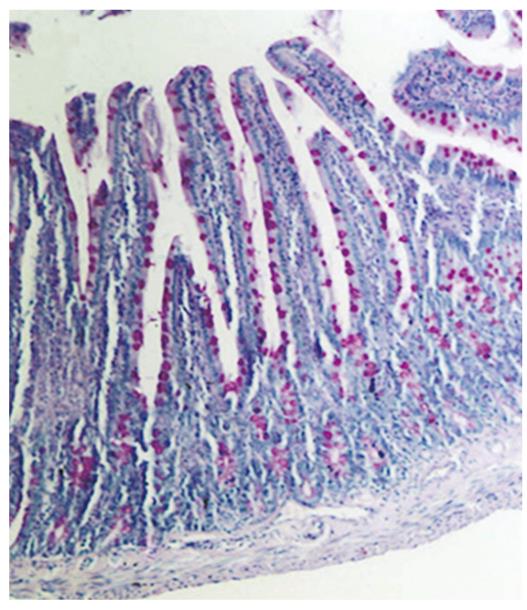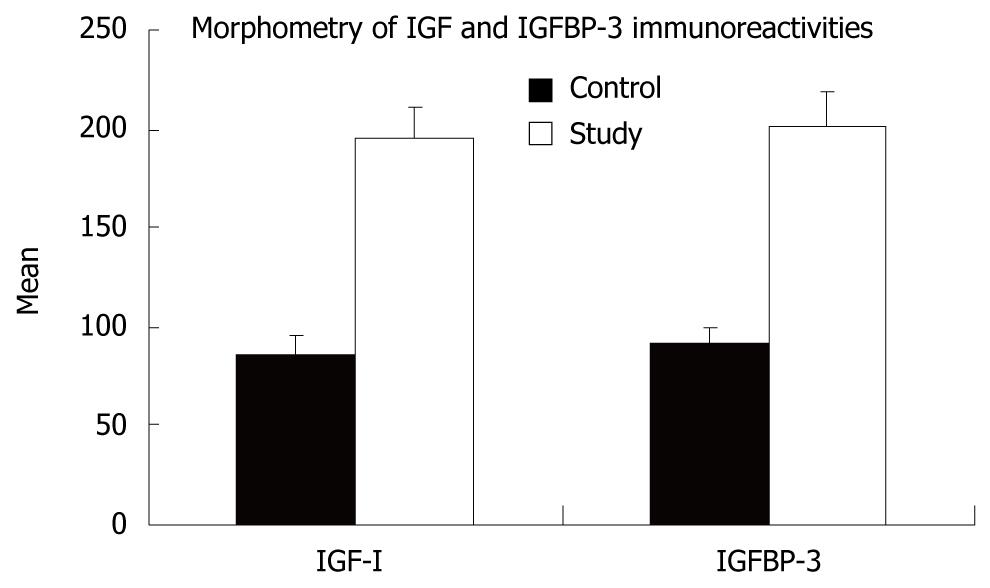Copyright
©2009 The WJG Press and Baishideng.
World J Gastroenterol. Nov 21, 2009; 15(43): 5418-5424
Published online Nov 21, 2009. doi: 10.3748/wjg.15.5418
Published online Nov 21, 2009. doi: 10.3748/wjg.15.5418
Figure 1 Photomicrograph of the tunica mucosa (M) and muscularis mucosa (MM) of the small intestine in the GH-administered group.
Villous hypertrophy and increased goblet cells were seen in the small intestine. PAS, × 100 (Original magnification).
Figure 2 Morphometric criteria to determine the effects of growth hormone on small intestine.
VH: The height of villus; LP: Lamina Propria; SM: Submucosa; ME: Muscularis externa; ET: Thickness of epithelium; CE: Crypt epithelial cell; GS: The size of goblet cell; GN: The number of goblet cells per villus. Height of the villi, epithelial thickness, and crypt epithelial cell number rats given GH were significantly increased (P < 0.01). The size and the number of goblet cells were also significantly increased (P < 0.05).
Figure 3 Like growth factor (IGF)-R immunoreactivity pattern in small intestines of the rats in the study group given growth hormone (A) and control group (B) by using the immuno-peroxidase technique.
While weak to moderate IGF-R immunostaining was observed in the epithelial cells of the small intestines in the control group, an increase in the immunostaining was seen in the study group. Note the strong immunoreactivity in the epithelial component and the moderately immunostained smooth muscle of the muscularis mucosa. Goblet cells display little or no immunoreactivity, in contrast to the dense immunoreaction in columnar cells of the study group. × 100 (Original magnifications).
Figure 4 Immunoreactivity of IGF-I was seen in the small intestine of the control group (A) and the study group (B) by using an immunofluorescence technique.
Increased immunoreactivity was seen in the study group. × 200 (Original magnifications).
Figure 5 Immunoreactivity of IGF-binding protein 3 (IGFBP-3) was seen in the small intestines by using an immunofluorescence technique in the control group (A) and the study group (B).
Increased immunoreactivity was seen in the study group. × 200 (Original magnifications).
Figure 6 IGFBP-3 and IGF-I immunoreactivities in rat small intestine epithelium in the control and the study groups using the indirect immunofluorescence method.
(Weak immunostaining: +; Moderate immunostaining: ++; Strong immunostaining: +++). In rats that were given growth hormone, there was a statistically significant increase in the immunoreactivities of IGF-I.
- Citation: Ersoy B, Ozbilgin K, Kasirga E, Inan S, Coskun S, Tuglu I. Effect of growth hormone on small intestinal homeostasis relation to cellular mediators IGF-I and IGFBP-3. World J Gastroenterol 2009; 15(43): 5418-5424
- URL: https://www.wjgnet.com/1007-9327/full/v15/i43/5418.htm
- DOI: https://dx.doi.org/10.3748/wjg.15.5418














